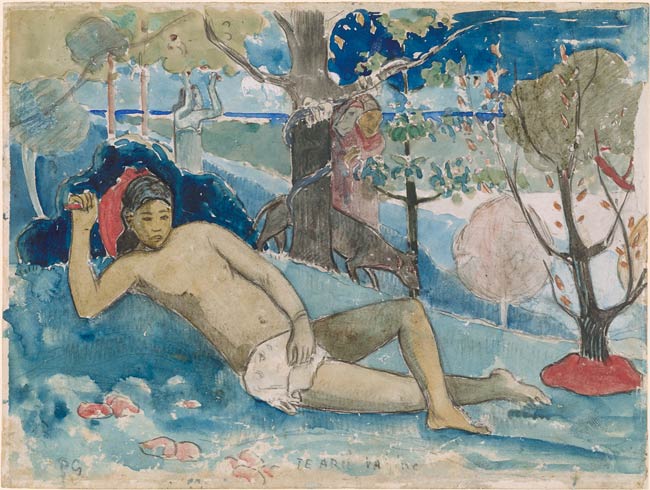

Gauguin had already achieved some measure of notoriety and artistic success after his first trip to the French colony of Tahiti in 1891-93, before returning to the island in 1895 at the age of forty-seven. He found the colonial capital Papeete too French, and set up his home and studio in Punaauia, along the coast. There he produced his first major work since his return, the canvas Te arii vahine (often translated as The Queen of Beauty, The Noble Woman, or The King's Wife), which he characterized as “much better than anything I've done previously” in a letter to Georges Daniel de Monfried, in April 1896 (Joly-Segalen 1950, no. 21).
The vahine (Polynesian girl) who Gauguin depicted was Pahura a Tai, the thirteen-year- old daughter of a neighbor who joined Gauguin's household, living with him from January 1896 until his departure for the Marquesas in 1901. She gave birth to their daughter in 1896. The painting marks the start of a series of nude Polynesian women, indebted to the conventions of Western art, which strip away the colonial garments to perpetuate an untouched, and thus “authentic” Tahitii.
Gauguin shipped the painting to Ambrose Vollard in Paris for the dealer's 1898 exhibition of the artist's work. The present watercolor roughly replicates the composition but does not fully convey the “deep sonorous colors” that Gauguin used in the painting. The small watercolor has the hallmarks of a record drawing, which could have been shared with Vollard or other correspondents in advance of the canvas while work was still underway. In fact, Gauguin included a watercolor illustration of the painting, again with numerous slight alternations, in a letter to his friend and fellow artist Georges Daniel de Monfried in April 1896 (Washington and elsewhere 1988, no. 215a).
Quite pleased with the reclining figure, Gauguin used it again in a woodcut of 1898, of which about thirty impressions were produced (see Metropolitan Museum of Art, 26.47). It was reconfigured as a headpiece for the newspaper Gauguin founded in Papeete, Le Sourire, although only four trial proofs survive (see Mongan et al. 1988, no. 72). The figure also appears as a pen- and-ink illustration to his 1903 manuscript Avant et après (Courtauld Gallery, London, p. 121).
The verso contains a study of a young girl seen in three-quarter view and a lightly sketched study of feet related to a painting of late 1896 or early 1897, Te tamari no atua (Neue Pinakothek, Munich). The painting depicts a Nativity scene with Polynesian women, including a young girl lying on a bed, whose feet correspond closely to those in the sketch. Holding a child in the left middle ground is a girl who, though shown in profile, has features similar to the girl in the sketch.
Initialed by the artist at lower left, in black crayon, PG; inscribed at lower center, in black crayon, TE ARII VAHINE.
Vollard, Ambroise, 1867-1939, former owner.
Bodenhausen, Baron von, former owner.
Cheney, Ward, former owner.
Cheney, Ward, Mrs., former owner.
Thaw, Eugene Victor, former owner.
Thaw, Clare, former owner.
The Morgan Library & Museum, New York, NY, "Drawn to Greatness: Master Drawings from the Thaw Collection", 2017. Exh. cat., no. 144, repr.
Denison, Cara D. et al. The Thaw Collection : Master Drawings and New Acquisitions. New York : Pierpont Morgan Library, 1994, no. 89.
The Art of Paul Gauguin. Washington, Chicago, and Paris: National Gallery of Art, Art Institute of Chicago, and Galeries nationales du Grand Palais, 1988, no. 215 and 215a.
The Lure of the Exotic: Gauguin in New York Collection. New York: The Metropolitan Museum of Art, 2002, cat. no. 96, p. 122.
From Leonardo to Pollock: Master drawings from the Morgan Library. New York: Morgan Library, 2006, cat. no. 92, p. 192-193.
